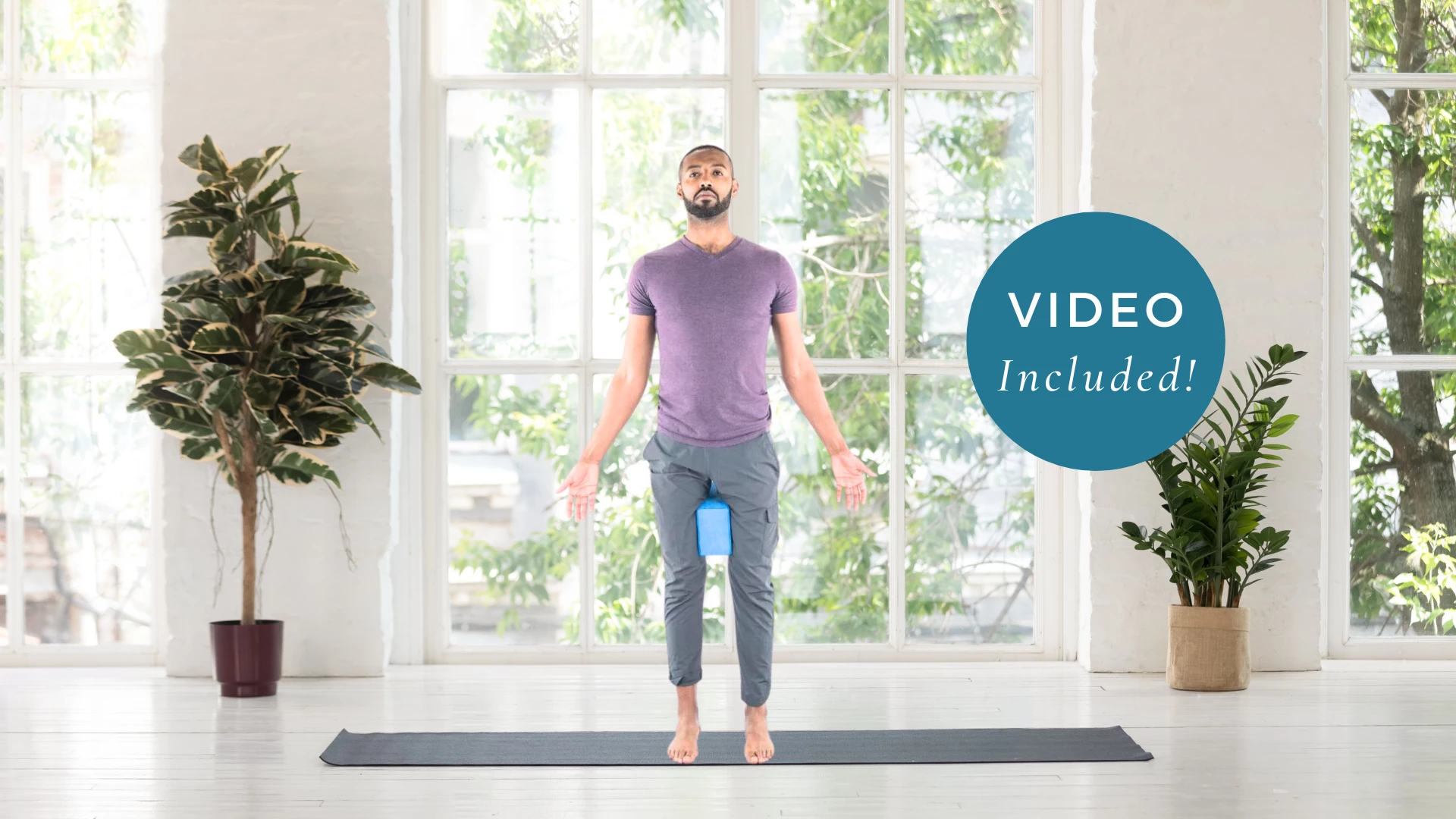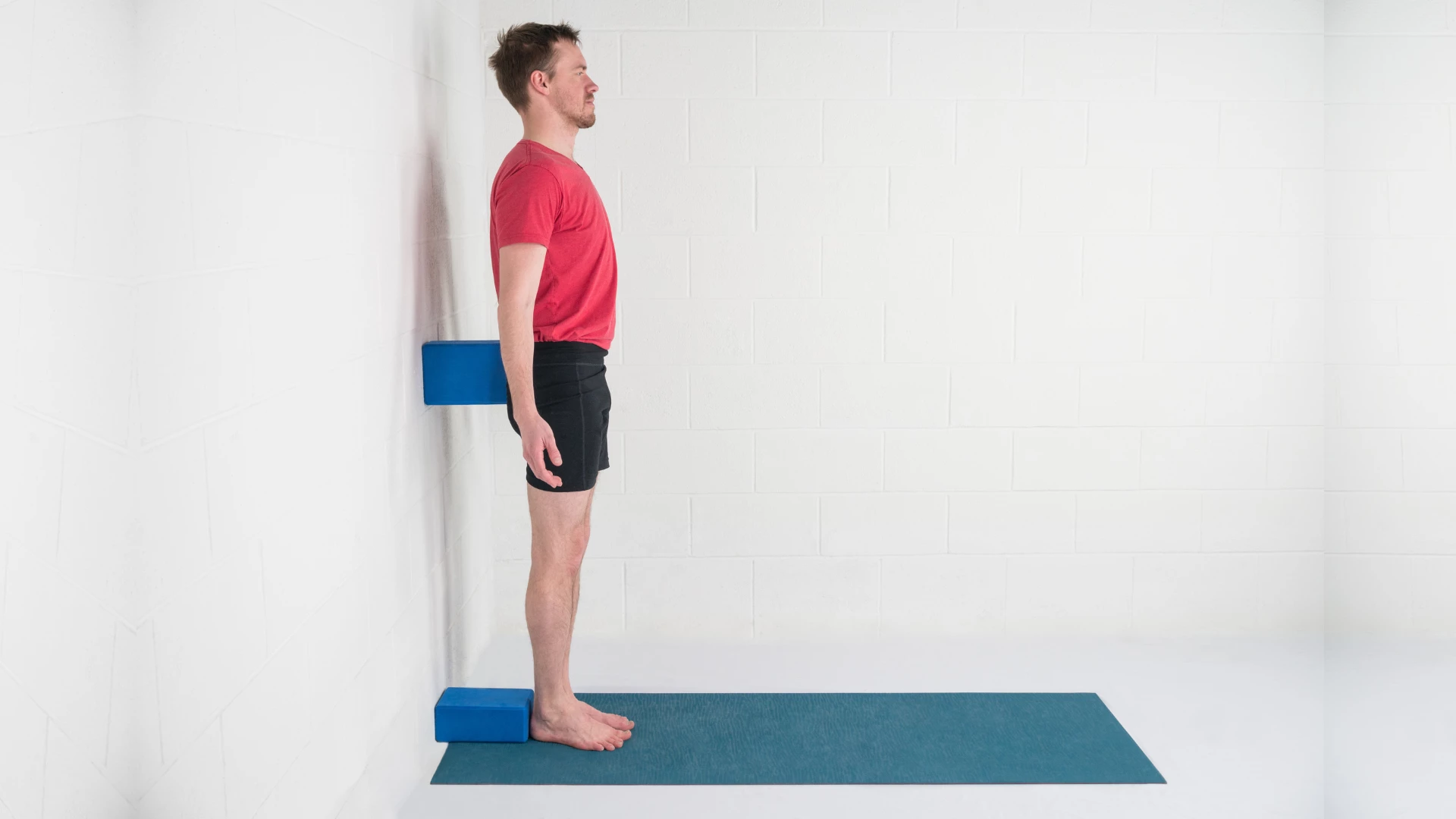Mountain Pose: How to Practice Tadasana at the Wall

Article At A Glance
Explore the many benefits of creating a solid foundation in Tadasana or Mountain Pose practiced at the wall using yoga blocks to create greater spinal stability to grow your practice.
Tadasana (Mountain Pose) is a foundational posture in the yoga tradition. As a primary standing pose, Tadasana is considered to be the “root” of all other poses in the yogic repertoire.
Despite looking like a simple standing position, Tadasana actually requires great effort and great body awareness to be able to practice with integrity and intention.
Because proprioceptive skills are not easy, many practitioners are simply unaware of the way they typically hold their posture. And the patterns and habits of everyday life easily seep into a yoga practice.
Many of us spend increasing amounts of time sitting at a desk, hunched over a computer. And, when practiced repetitively (like all day, every day), this simple posture can lead to long-term changes in the tissues of our bodies. This, then, translates onto our yoga mats.
Thus, revisiting foundational yoga poses from time to time can be hugely beneficial for our practice as a whole. And one of the best places to start to work on refining and examining optimal alignment is in Mountain Pose.
Refine Yoga’s Mountain Pose With This Propped Variation At the Wall:
For this variation of Mountain Pose, you will need wall space and two (or three) yoga blocks.

To Practice:
- Place one block at its lowest height on the floor with the short edge of the block against the wall.
- Come to stand in front of the block with your back to the wall and your heels touching the block behind you. Your feet can be together, hip-distance apart, or any distance from each other that feels stable for your body. With your feet wider, you may want to use two blocks to be able to make contact with your heels and the block(s).
- Take another block behind you with the short edge touching the wall and the other side behind your sacrum (the triangular-shaped bone below your lower back and above your tailbone).
- Create length in your spine by reaching your tailbone and the crown of your in opposite directions. Gently press back against the block behind your sacrum to find the natural inward curvature of your lumbar spine (lower back).
- Balance your weight across your feet as you root down into the tripod base of your feet. Ground down equally into the mound underneath your big toe, the mound underneath your pinky toe, and the heel of your foot.
- As you root down into the earth, feel the ground reaction force send energy back up through your whole body as you create even more length in your spine and space between each vertebra.
- Firm your belly and imagine tightening a corset around your whole waistline to support your spine and create more lift in your torso.
- Soften the weight of your shoulders away from your ears.
- Ever so slightly, broaden your chest, allowing your collarbones to “smile.”
- Reach down through your fingertips, sending energy toward the floor.
- Stack your ears over your shoulders, your shoulders over your ribcage, your ribcage over your pelvis, your pelvis over your knees, and your knees over your ankles.
- Observe the effortlessness of this neutral bony alignment along with the energizing support of your musculature.
- Deepen your breath and pause here for a moment to place this neutral positioning into your muscle memory.
Options:
- You can stretch both arms up overhead as you lift the sides of your torso into Urdhva Hastasana (Upward Salute) while maintaining neutrality throughout the plumb line of your body.

- You can release the block from behind your sacrum and add load to your shape as you reach the block up overhead and hold it between both hands. Maintain a neutral, lengthened spine as you lift your ribcage up away from your pelvis.
- Maybe close your eyes to draw your awareness inward and feel the positioning of your body in space. Find neutrality and balance from this place of proprioception.
- Play with pranayama in this shape, perhaps elongating your inhales, or your exhales to draw a deeper stretch into your accessory breathing muscles (such as your intercostal muscles between your ribs).
Never Underestimate the Power of Simplicity and Stability in Tadasana
Although Tadasana looks like an “easy” pose to master, it is actually a real challenge for most practitioners. Finding neutrality in the pelvis, spine, and shoulder girdle can prove to be difficult for those of us who sit and/or type for most of the day.
However, finding this neutrality can be crucial to the overall health of our bodies and to the way that our posture affects our yoga practice as a whole.
So try this variation of Tadasana or Mountain Pose at the Wall and see how it works for your body and helps you neutralize in ways you probably didn’t even know you needed. You might be surprised to see how much it affects your practice overall.
Also, read...
Wall Yoga Exercises: Why Practice Yoga at the Wall?
5 Chaturanga Prep Poses That Look Nothing Like Chaturanga
3 Simple Warrior 3 Modifications to Find Your Balance
Related courses
Journey to Center: A Yoga Guide to Unlock the Full Potential of Your Core
Yoga for Healthy Hips: Principles for a Safe Practice
Need an Energy Makeover? How Yoga Can Help You Boost Vitality

Leah Sugerman is a yoga teacher, writer, and passionate world traveler. An eternally grateful student, she has trained in countless schools and traditions of the practice. She teaches a fusion of the styles she has studied with a strong emphasis on breath, alignment, and anatomical integrity. Leah teaches workshops, retreats, and trainings, both internationally and online. For more information, visit www.leahsugerman.com.
